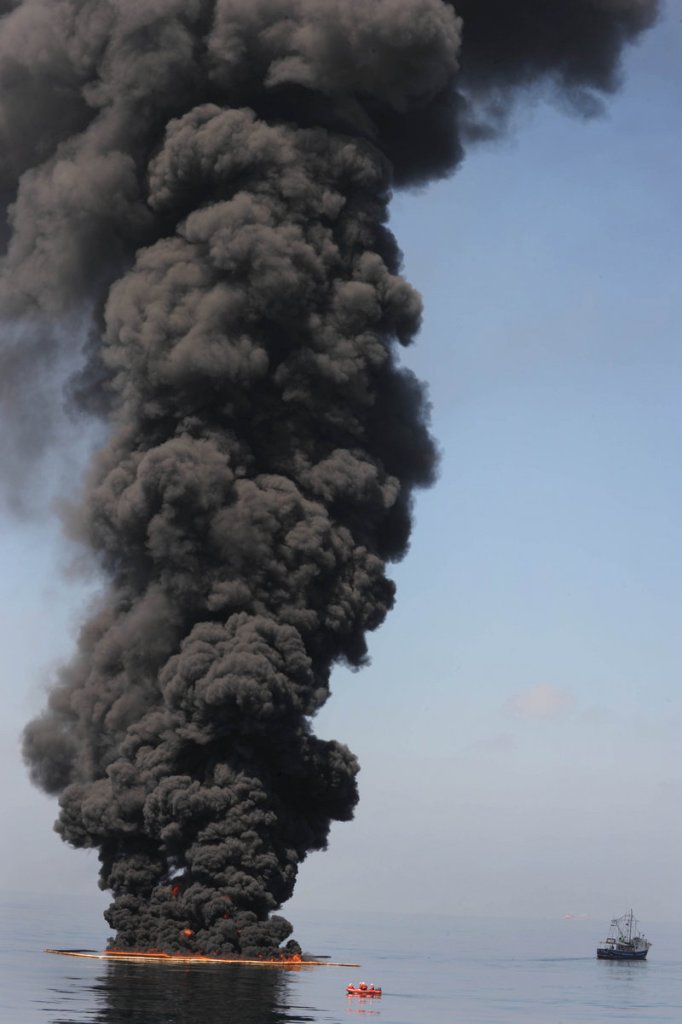ON THE GULF OF MEXICO – The deadly blowout of an oil rig in the Gulf of Mexico was triggered by a bubble of methane gas that escaped from the well and shot up the drill column, expanding quickly as it burst through several seals and barriers before exploding, according to interviews with rig workers conducted during BP’s internal investigation.
While the cause of the explosion is still under investigation, the sequence of events described in the interviews provides the most detailed account of the April 20 blast that killed 11 workers and touched off the underwater gusher that has poured more than 3 million gallons of crude into the Gulf.
Portions of the interviews, two written and one taped, were described in detail to an Associated Press reporter by Robert Bea, a University of California Berkeley engineering professor who serves on a National Academy of Engineering panel on oil pipeline safety and worked for BP PLC as a risk assessment consultant during the 1990s. He received them from industry friends seeking his expert opinion.
On Friday, an ecosystem, an economy and a way of life for much of the nation’s coastal Southeast hung in the balance as robots, guided by handlers in Houston, finally set a giant box on top of the oil leak.
Now they will try to hook up a huge funnel that can suck the oil up and into tankers, perhaps as early as Monday. But there are several steps on the way to that fix, each one unprecedented and perilous.
“We’re captives to the tyranny of what I call the distant depth, and there is no human access to the site of the spill,” said Coast Guard Adm. Thad Allen, the coordinating commander of a response that includes nearly 8,500 personnel and 260 vessels.
Seven BP executives were on board the Deepwater Horizon rig celebrating the project’s safety record at the time of the explosion, according to the rig workers’ interview transcripts. Meanwhile, far below, the rig was being converted from an exploration well to a production well.
As the workers removed pressure from the drilling column and introduced heat to set the cement seal around the wellhead, the chemical reaction created heat, destabilizing the seal and allowing a gas bubble to form inside the pipe.
Deep beneath the seafloor, methane gas is in a slushy, crystalline form. But as the bubble rose up the drill column from the high-pressure environs of the deep to the less pressurized shallows, it intensified and grew, breaking through various safety barriers, the interviews said.
“A small bubble becomes a really big bubble,” Bea said. “So the expanding bubble becomes like a cannon shooting the gas into your face.”
Up on the rig, the first thing workers noticed was the seawater in the drill column suddenly shooting back at them, rocketing 240 feet in the air. Then, gas surfaced. Then oil.
“What we had learned when I worked as a drill rig laborer was swoosh, boom, run,” Bea said. “The swoosh is the gas, boom is the explosion and run is what you better be doing.”
The gas flooded into an adjoining room with exposed ignition sources, he said.
“That’s where the first explosion happened,” said Bea, who worked for Shell Oil in the 1960s during the last big northern Gulf of Mexico oil well blowout. “The mud room was next to the quarters where the party was. Then there was a series of explosions that subsequently ignited the oil that was coming from below.”
The executives were injured but survived, according to one account. Nine rig crew on the rig floor and two engineers died.
BP spokesman Daren Beaudo said he could not immediately comment on the report.
Globs and slicks of the burnt orange gunk drifted ever closer to the mouth of the Mississippi River and land Friday. The slick now is larger than Maryland.
Officials shut down further fishing grounds, effectively putting out of work hundreds more in an industry that is the lifeblood of the region, as well as the Breton National Wildlife Sanctuary. Out in the Gulf, birds dove into oily water, dolphins coughed and sharks swam in weird patterns, said marine specialists who have been out on the water tracking the disaster.
Meanwhile, two weeks after the spill and three weeks from hurricane season, Louisiana officials spoke with urgency about keeping the noxious sludge out of the marshes that are New Orleans’s protection from a storm surge.
“The unfortunate reality today is that it is no longer “what if,” said Craig Tafarro, president of St. Bernard Parish, after a helicopter flyover of the area revealed more gooey tendrils reaching out for parish wetlands.
Some experts at oil cleanup said the balling and globbing of the oil, clearly visible on underwater video as workers lowered the container dome onto the well, may be a result of the heavy application of chemical dispersants near the leak.
Responders to the downed Deepwater Horizon rig have spent days applying more than 267,000 gallons of oil dispersant to break up the tens of thousands of gallons of oil that have reached the ocean’s surface.
EPA Administrator Lisa Jackson said Friday that the government was not yet ready to proceed with widespread sub-sea chemical dispersants, which work the same way dishwashing liquid works on grease, by breaking up the oil into tiny droplets. “So far the sampling is inconclusive or incomplete,” she said. Scientists and policymakers agree that the oil from the spill poses a greater threat to wildlife and vegetation than the chemicals in the dispersants, but it’s unclear whether these compounds will wreak havoc over time.
Send questions/comments to the editors.


